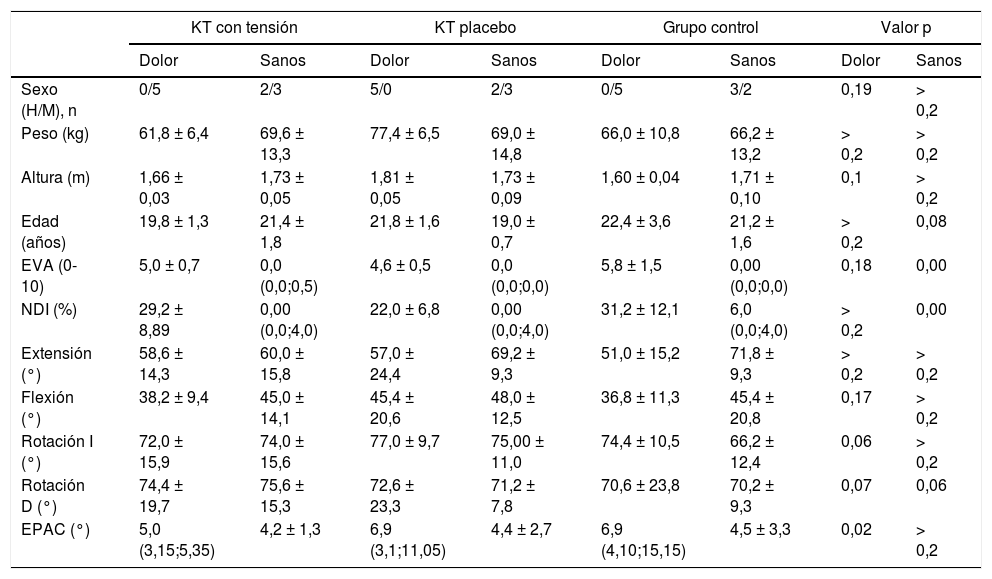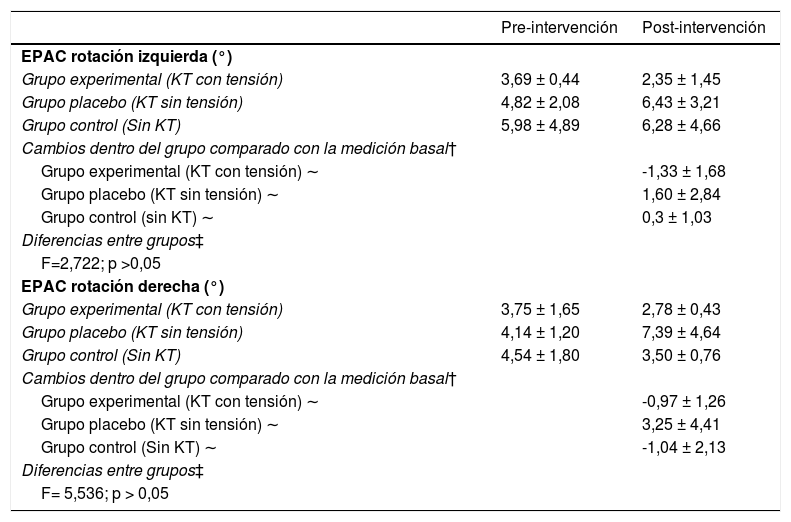El objetivo principal de este estudio piloto es comparar los cambios en el error de posicionamiento articular cervical (EPAC) entre tres grupos de intervención. El objetivo secundario es analizar las diferencias de las intervenciones sobre el EPAC en presencia o ausencia de dolor cervical crónico.
Material y métodosSe incluyó en el estudio una muestra de 15 participantes sin dolor cervical y una muestra de 15 personas con dolor cervical crónico. Cada una de las muestras fue asignada de manera aleatoria a uno de los tres grupos de intervención: un grupo experimental (aplicación de vendaje neuromuscular con tensión del 25%), un grupo placebo (aplicación de vendaje neuromuscular sin tensión) y un grupo control (sin aplicación de vendaje neuromuscular). Se realizó un análisis estadístico para examinar las diferencias dentro de los grupos, entre los grupos y entre muestras.
ResultadosNo se encontraron diferencias estadísticamente significativas (p > 0,05) tras las intervenciones dentro de ningún grupo en ninguna de las dos muestras. No se observaron diferencias estadísticamente significativas entre grupos dentro de la misma muestra (p > 0,05) ni entre muestras (p > 0,05).
ConclusionesLos resultados del presente estudio piloto sugieren que la aplicación de vendaje neuromuscular con o sin tensión no inducen cambios diferentes a la ausencia de su aplicación en sujetos sanos ni en aquellos con dolor cervical. Futuros estudios son necesarios para objetivar la ausencia de cambios clínicos, utilizando una mayor muestra y mayor número de intervenciones y mediciones en el tiempo.
The main aim of this pilot study is to compare changes in Joint Position Sense Error (JPSE) between three intervention groups. The secondary aim is to analyse the differences of the interventions on JPSE in the presence and absence of pain.
Material and methodsA sample with fifteen healthy subjects and another sample with fifteen patients with chronic neck pain were included in this study. Each sample was randomly assigned to one of the intervention groups: an experimental group (25% neuromuscular taping with tension), a placebo group (neuromuscular taping with no tension), and a control group (with no neuromuscular taping). Statistical analyses were performed to assess the effects within groups, between groups and between samples.
ResultsNo statistically significant differences (p > 0.05) were found after interventions in either group, neither the healthy sample nor the patient sample. No statistically significant differences were found between groups within the same sample (p > 0.05), or between samples (p > 0.05).
ConclusionsThe results from the present pilot study suggest that the application of neuromuscular taping with or without tension does not induce JPSE changes compared to not applying it in healthy patients or those with neck pain. Further research is needed to determine the absence of clinical effect, with a larger sample, a greater number of interventions and measurements over time.
Article
Si ya tiene sus datos de acceso, clique aquí.
Si olvidó su clave de acceso puede recuperarla clicando aquí y seleccionando la opción "He olvidado mi contraseña".












